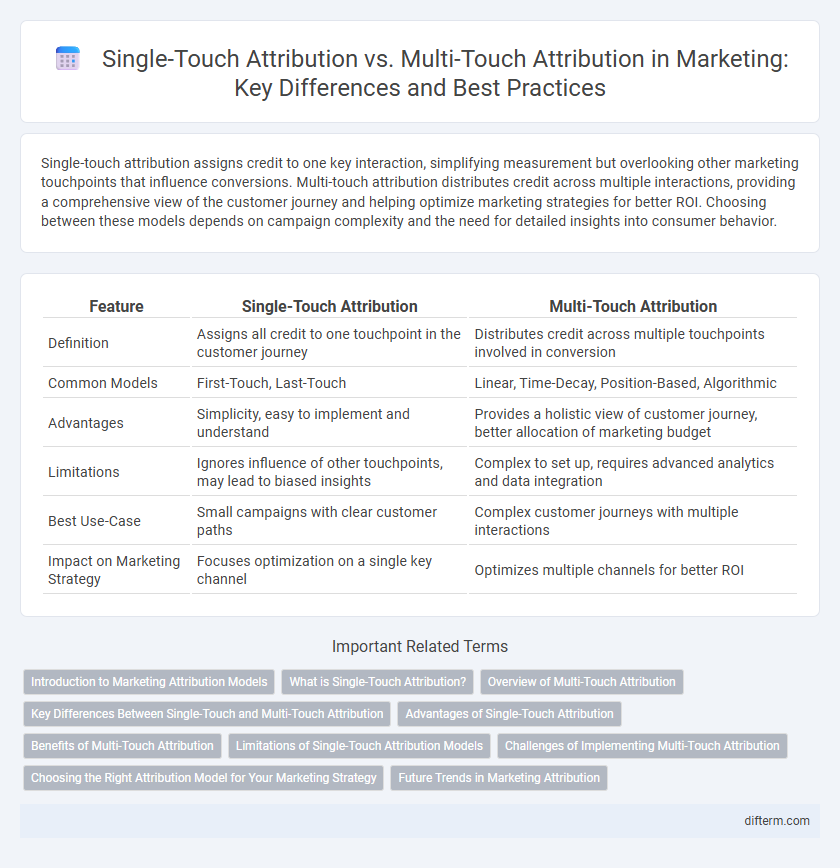Single-touch attribution assigns credit to one key interaction, simplifying measurement but overlooking other marketing touchpoints that influence conversions. Multi-touch attribution distributes credit across multiple interactions, providing a comprehensive view of the customer journey and helping optimize marketing strategies for better ROI. Choosing between these models depends on campaign complexity and the need for detailed insights into consumer behavior.
Table of Comparison
| Feature | Single-Touch Attribution | Multi-Touch Attribution |
|---|---|---|
| Definition | Assigns all credit to one touchpoint in the customer journey | Distributes credit across multiple touchpoints involved in conversion |
| Common Models | First-Touch, Last-Touch | Linear, Time-Decay, Position-Based, Algorithmic |
| Advantages | Simplicity, easy to implement and understand | Provides a holistic view of customer journey, better allocation of marketing budget |
| Limitations | Ignores influence of other touchpoints, may lead to biased insights | Complex to set up, requires advanced analytics and data integration |
| Best Use-Case | Small campaigns with clear customer paths | Complex customer journeys with multiple interactions |
| Impact on Marketing Strategy | Focuses optimization on a single key channel | Optimizes multiple channels for better ROI |
Introduction to Marketing Attribution Models
Single-touch attribution assigns credit to a single marketing touchpoint, such as the first or last interaction, simplifying performance measurement but potentially overlooking the influence of other channels. Multi-touch attribution distributes credit across multiple touchpoints throughout the customer journey, providing a more comprehensive view of how different marketing efforts contribute to conversions. Choosing the right attribution model depends on campaign complexity, customer behavior analysis, and the need for accurate ROI insights.
What is Single-Touch Attribution?
Single-touch attribution assigns 100% of the credit for a conversion to one specific marketing interaction, typically the first or last touchpoint in the customer journey. This model simplifies analysis by pinpointing a single source, such as a paid search ad or an email campaign, as responsible for driving the conversion. While easy to implement, single-touch attribution often overlooks the influence of multiple channels that contribute to customer decisions over time.
Overview of Multi-Touch Attribution
Multi-touch attribution assigns value to multiple marketing touchpoints along the customer journey, enabling a comprehensive understanding of campaign effectiveness. This model leverages data from channels such as social media, email, paid search, and direct visits to distribute credit proportionally, enhancing budget allocation decisions. Employing multi-touch attribution improves ROI by identifying key interactions that influence conversion, unlike single-touch attribution which attributes credit to only one point of contact.
Key Differences Between Single-Touch and Multi-Touch Attribution
Single-touch attribution assigns credit to only one marketing touchpoint, typically the first or last interaction, providing a simplified view of campaign performance. Multi-touch attribution distributes credit across multiple interactions, offering a comprehensive understanding of the customer journey and the contribution of each channel. The key difference lies in the granularity of data analysis, with multi-touch enabling more precise optimization of marketing strategies compared to the limited insights from single-touch models.
Advantages of Single-Touch Attribution
Single-touch attribution simplifies marketing analysis by assigning credit to one key interaction, making it easier to track the most effective channel or campaign. This model reduces data complexity, allowing marketers to quickly identify high-impact touchpoints such as first-click or last-click, enhancing budget allocation efficiency. It also minimizes the risk of over-attribution commonly seen in multi-touch models, leading to clearer insights for decision-making.
Benefits of Multi-Touch Attribution
Multi-touch attribution provides a comprehensive view of the customer journey by assigning credit to multiple marketing touchpoints rather than just one, enhancing accuracy in campaign performance analysis. This model helps marketers optimize budget allocation by identifying which channels and interactions contribute most effectively to conversions. Leveraging data from diverse touchpoints enables more informed decision-making, driving improved ROI and personalized marketing strategies.
Limitations of Single-Touch Attribution Models
Single-touch attribution models attribute 100% of conversion credit to a single interaction, often oversimplifying the customer journey and overlooking the influence of multiple touchpoints. This approach can lead to inaccurate assessments of marketing channels, skewing budget allocation and undervaluing upper-funnel activities like brand awareness campaigns. Marketers relying solely on single-touch attribution risk missing insights into the complex path-to-purchase dynamics essential for optimizing multi-channel strategies.
Challenges of Implementing Multi-Touch Attribution
Implementing multi-touch attribution faces significant challenges, including integrating data from numerous marketing channels and accurately assigning value to each consumer interaction. Complex algorithms and cross-device tracking demand advanced analytics capabilities and often require substantial investment in technology and expertise. Additionally, privacy regulations and incomplete data pose obstacles to achieving precise attribution models, complicating decision-making and campaign optimization.
Choosing the Right Attribution Model for Your Marketing Strategy
Single-touch attribution models assign credit to a single marketing interaction, often simplifying analysis but potentially overlooking the full customer journey. Multi-touch attribution distributes credit across multiple touchpoints, providing a more comprehensive view of how various channels contribute to conversions. Selecting the ideal attribution model depends on your marketing goals, data availability, and the complexity of your customer journey to optimize budget allocation and campaign effectiveness.
Future Trends in Marketing Attribution
Future trends in marketing attribution emphasize the integration of AI-powered analytics and machine learning algorithms to enhance the accuracy of multi-touch attribution models. Advanced data processing capabilities enable marketers to track consumer journeys across multiple channels in real-time, improving attribution precision and budget allocation. Privacy-centric solutions like differential privacy and server-side tracking are also reshaping attribution frameworks to comply with evolving data protection regulations.
Single-touch attribution vs Multi-touch attribution Infographic

 difterm.com
difterm.com